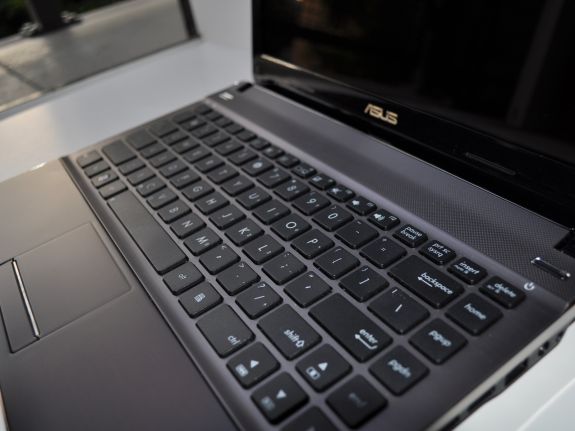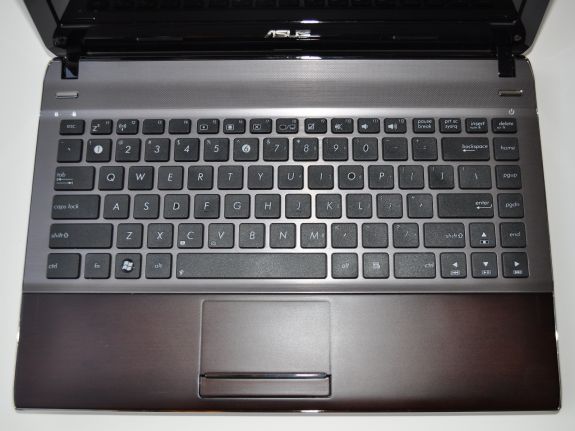Asus U33Jc: Much Ado About Bamboo
by Vivek Gowri on July 29, 2010 9:01 AM ESTASUS U33Jc - In and Around
Given ASUS’ boasts about the strength of bamboo, I was really dying to see the build quality of the U33. And I can report that overall, it’s pretty good. The interior is rock solid, between the bamboo assembly for the palm rests and touchpad and the brushed aluminum for the keyboard tray and speaker grille. There's no flex to speak of anywhere, with the chiclet keyboard also being flex free. The display assembly on the other hand… that I’m a bit less happy with. The lid exhibits some flex under pressure, and the display shows a bit of ripple effect, but overall it’s not too bad.
Aesthetically, what you think of the U33 depends on how you feel about the bamboo. Obviously, the dark-stained bamboo veneer is the main feature, but the chrome edges and the light brown brushed aluminum on the interior are nice touches which complement it. Usually, chrome is an absolute no on laptops (remember the awful HP notebooks with chrome trim?), but on the U33 the brightwork nicely offsets the dark wood. Overall, the look is pretty upscale, with a nice mix of the matte textured bamboo and the brighter and glossier metals. With that said, if you’re a fan of metal bodied laptops, you’ll probably be much happier with the aluminum casing used in the U30Jc and U35Jc.
The keyboard is definitely a plus point. I’d actually go so far as to rate this as one of the best keyboards in a consumer level machine. Obviously, it can’t touch the enterprise-class ThinkPads and Latitudes of the world, but it’s a very good keyboard. No flex to speak of, good spacing between keys, good layout, and a bit more key travel than most other thin and lights. The extra travel is what separates it from other good chiclet keyboards like on the MacBook and Sony’s 13”ers and gives it a more pleasant typing experience. It won’t wow you, but having a decent keyboard with no major flaws is actually pretty nice for a midrange consumer machine. It’s surprising to see how many major manufacturers manage to screw up the keyboard (Acer, Toshiba, I’m looking at you) and I’m glad to report that Asus hasn’t.
The touchpad is an interesting one. It’s part of the same bamboo panel that makes up the palmrest. The touchpad circuitry itself is made by Elan Microelectronics and accounts for the extra thickness added by the bamboo panel and has some multitouch gestures not yet implemented by Synaptics. I was pretty impressed that they managed to get the touchpad to work smoothly even with the thicker wood and plastic covering the sensor. It’s interesting to have a bamboo texture underneath, but other than that, the touchpad just works. The mouse buttons are also covered by wood to keep the aesthetic uniform.
The ports are actually pretty good, even better than the U30Jc. We’re talking 2 USB 2.0, one USB 3.0, HDMI, VGA, headphone out, line in, a memory card reader, and Intel’s Wireless Display. I’m a bigger fan of WiDi than some people, since seamlessly streaming your laptop’s display to your HDTV is a pretty sweet innovation - it’s a wireless HTPC! I wrote about it at length in my Mobile Buyer’s Guide last week, so you can read more about it there. The USB 3.0 port is another premium touch that is exclusive to the U33Jc amongst Asus’ plethora of thin and light notebooks, and while I don’t see it being particularly useful for everyone, it should be a godsend for people that have USB 3.0 external hard disks. Beyond that, the port selection is about par for the thin and light class.
The speakers are located at the top of the keyboard, which is a nice change from all the other portables that have the speakers under the front edge. Output and sound quality are decent for a small notebook, but for any kind of serious listening you will want to connect to a good speaker system or headphones of some kind. The webcam is nice in that it has a physical shutter to open and close, so you are ensured of privacy. I didn’t get a whole lot of time to test the webcam and mic functionality for videoconferencing, but I saw nothing to suggest that they wouldn’t be perfectly adequate for Skype.












34 Comments
View All Comments
JarredWalton - Thursday, July 29, 2010 - link
I'd guess Apple probably spends about $50 more on their LCD... $100 tops. RGB LED backlit panels are prohibitively expensive, but for standard LED backlighting at a fixed size of 13.3", you're looking at probably $100 for a base panel and $150 for a quality panel. The problem is, most marketing departments are focused on all of the other stuff: you can loudly proclaim better battery life, a faster processor, USB 3.0, etc. but when was the last time you saw a consumer notebook on sale with a sticker that says, "High contrast, high color LCD with an 800:1 contrast ratio!" The closest I've ever come to seeing that is with RBG LED backlighting... which adds ~$150 to $200.Souka - Thursday, July 29, 2010 - link
Too bad on the LCD.I suspect if they had a "+" model which had a better LCD for $100 more they'd sell.
Oh well... my wife's IBM Thinkpad T30 (Pentium 4M cpu) will have to last a bit longer! :)
AnnonymousCoward - Tuesday, August 3, 2010 - link
I agree, Jarred, that it's probably marketing to blame. I hate TN and would always pay for IPS given the choice. Also, 16:9 sucks, as does 768 vertical pixels on a C2D machine.VivekGowri - Thursday, July 29, 2010 - link
While that's true, remember back to before Core 2010 released. The MBP13 was as fast as any of the regular Core 2 Duo notebooks and still had the same screen. So while the current MBP is basically Apple getting away with highway robbery (again), it's not like they can only put in a good display because they're fleecing customers. It's always had a good display. Fair point with the 20% more expensive, but see if you can find me a $1200 13" notebook with a decent display. PC makers just figure to save money with the LCDs in all but the highest end notebooks, which is really disappointing.(The base MacBook is a whole different story - Apple's as guilty as anyone for mediocre quality screens there.)
erple2 - Saturday, July 31, 2010 - link
How's the display on the Envy 14 with the 1600x900 display? That's about 1100 for the "Radiance Display"...PlasmaBomb - Saturday, July 31, 2010 - link
It's supposed to be pretty good, and when the E14 first launched it had the radiance display at $999.crydee - Thursday, July 29, 2010 - link
But I needed a laptop sooner than that. Disappointing this is it after such a long wait. Even on the JTszoxo - Thursday, July 29, 2010 - link
Arguably the most important part of a notebook is the display, since afterall it is the part you stare at, yet manufacturers consistently try to shove these horrible displays down our throats.Stupid glare-type surface, horrible contrast, bad colour representation, terrible black levels, narrow viewing angles. I really don't understand why people buy those things, and some even seem to like them...
Atleast manufacturers now seem to realise that the mirror-like surfaces on the palm rest, keyboard, and bezel are not necessarily good things, and try to move towards matte/textured surfaces.
AstroGuardian - Friday, July 30, 2010 - link
Why would you say that? When being a PRO only thing you care while using the laptop is visible characters and performance. Why would it be crucial for the display to be high quality? Display is a display. On that kind of computer it's enough for the display to be clear and illuminated. But i agree with the fact that 1366x762 is a lousy resolutionzoxo - Friday, July 30, 2010 - link
When I work on a computer, and look at the screen, I want to see what's on the screen, not my reflection/the window or whatever is behind me. I want to actually be able to distinguish red from orange, black from gray. I think a screen is extremely important when you want to look at it for more than 10 minutes at a time.